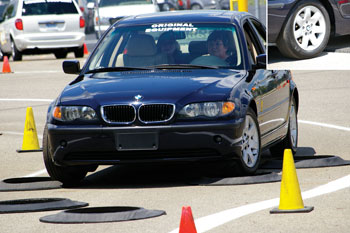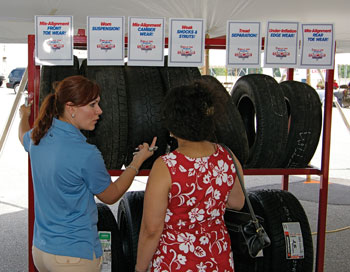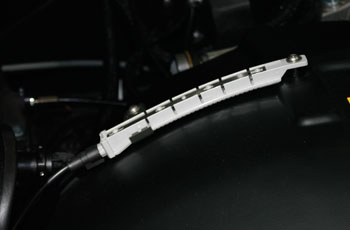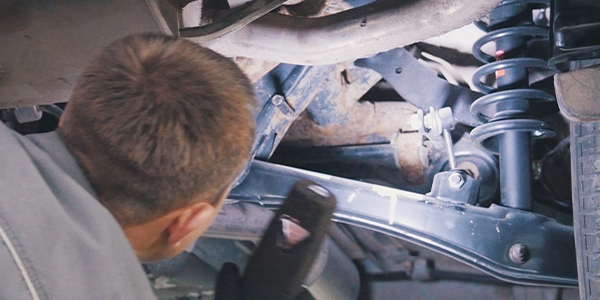As a vehicle brakes, accelerates and corners, weight is transferred and the vehicle attitude changes. If  done in a controlled manner, it can transfer weight effectively to the wheel that needs it the most. For the most part, the suspension handles the best when weight transfer is not sudden and the suspension is not compressed on the bump stops.
done in a controlled manner, it can transfer weight effectively to the wheel that needs it the most. For the most part, the suspension handles the best when weight transfer is not sudden and the suspension is not compressed on the bump stops.
The transfer of weight also can have momentum. If a driver is making a sudden lane change and a panic stop to the right, the weight of vehicle is transferred to the left-front wheel. If that corner of the vehicle has a weak shock or strut, the suspension could rapidly compress. As a result, the right-rear tire has less weight and less traction, as does the left-rear to a lesser extent. This means that the vehicle could go from an understeer condition to a "snap" oversteer very quickly. In the worst-case scenario, if the vehicle has a high center-of-gravity like an SUV, it could roll. If the vehicle has effective shocks or struts, the weight transfer is better controlled, as is the vehicle.
The role of shocks and struts becomes even more critical on vehicles equipped with ABS, traction control and stability control systems. As in an emergency lane change situation, the driver can now steer under panic braking. This means that weight transfer and vehicle pitch can be even more extreme.
Why shocks wear
The main reason why shocks wear is because they have a hard life. Even under normal conditions on a smooth road, shocks stroke on average 1,750 times for every mile traveled.
Inside a shock, a piston travels up and down a tube. In the piston, there are gaskets that seal the piston and tube. Wear can occur between the piston and tube, and, over a period of time, oil will pass between the piston and tube.
If the suspension bottoms out, contact between the piston and the bottom of the tube could occur. This can damage the piston and valving.
Also, if the shock is worn, the springs will have to work harder and could wear out sooner causing ride height and ride problems.
Shocks are filled mostly with oil. This oil can have different weights. When the oil heats up, it can effect the rate of flow through the valving as it either thins out or becomes more viscous. Some shock manufacturers also use multi-weight oils that work like motor oils. When the oil is cold, it may flow like 15-weight oil. But, as the oil heats up, it could flow like a 20-weight.
The oil can become contaminated with debris either from the outside or from internal components. Dirt can enter the shock through the gasket that seals around the rod. This is why it is critical to replace all dust boots when installing new shocks.
Mileage alone is a poor indicator of poor shocks. Some are still working reasonably well at more than 40,000 miles. And if a customer purchases really good shocks, they might reach 70,000 miles. Regular inspection is the only way to determine a strut’s or shock’s condition.
Gas Charged
There are basically three types of shock absorber designs: mono-tube high-pressure gas, twin-tube low-pressure gas and twin-tube hydraulic (non-gas). Each of these designs has certain ride and performance characteristics that can enhance the performance of a vehicle.
The reason why gas is added to some shock absorbers and struts is to reduce foaming or aeration of the oil in the shock that is caused by cavitation as the oil passes through the valving. Over time, shocks can lose this charge of gas. If all the gas escapes, the shocks can overheat and fade.
Add “Check the shock’s gas level” to your check list.
Valves
Shocks use valves to control the flow of the oil. Valves are located either in the piston or at the base of the shock. The rate of flow will control how much force it takes to move the piston.
Valving works in both directions of compression and rebound, and in most shocks, both are independent rates.
Valving in most replacement shocks is vehicle specific. When a vehicle is designed, the shock or strut is designed to dampen certain spring rates, work with a specific tire package and is tuned to vehicle dynamics desired by the OEM.
This is important to remember when selecting a replacement. A replacement that is too stiff could create a ride complaint from the customer.
Conventional shocks and struts are sometimes limited by their valving. Their performance is generally a compromise between a comfortable ride and one that is more controlled.
Some shocks and struts have tapered grooves in the walls of the tube that allow the fluid to freely flow around and through the piston in a certain range of travel. The result is a smooth and comfortable ride. When the piston travels beyond the tapered grooves, fluid is directed totally through the valving in the piston. This results in a stiffer shock. Remember, this shock is height sensitive and installing this type of unit on a vehicle with an altered ride height can negate its benefits.
The newest type of shock introduced into the aftermarket can sense changes in road conditions. In these shocks, the valving can determine if the stroke is a product of small bumps in the road or large changes in the vehicle’s attitude. The ability to sense between changes in the road surface and vehicle pitch allows the shock to provide a comfortable ride in addition to control in panic situations.
Struts
Struts are part of the suspension and they effectively replace the upper control arm and ball joint. Struts perform two main jobs. First, struts perform a shock-damping function like shock absorbers. Internally, a strut is similar to a shock absorber. A piston is attached to the end of the piston rod and works against hydraulic fluid to control spring and suspension movement. Compared to a shock, the rod of a strut is three times the diameter.
And like shock absorbers, a strut is velocity sensitive, meaning that it is valved so that the amount of resistance can increase or decrease, depending on how fast the suspension moves.
Struts also perform a second job. Unlike shock absorbers, struts provide structural support for the vehicle’s suspension. As a result, struts affect riding comfort and handling, as well as vehicle control, braking, steering, wheel alignment and wear on other suspension components, including the tires.
Because struts are part of the suspension, in some situations they wear differently than shocks. If the upper strut mount is binding, the force is transferred through the rod to the strut’s body. Inside the strut’s body, the rod is supported by the piston and at the top of the strut housing by a bushing or bearing. Wear can be dramatic because the strut has to do the work of the bearing. Instead of the strut bearing turning and pivoting, the piston turns in the strut housing, thereby creating wear.
Selling Extras
All struts and shocks should be replaced in sets of four. Replacing one or two at a time can create a balance problem that could make the vehicle unstable when braking and accelerating.
Bump stops that fit on the rod of a strut should always be transferred from the old assembly or replaced with new parts. This is cheap insurance against damaging the new unit if it bottoms out. Even if the old strut does not have one, check the parts catalog for a replacement.
Don’t forget the springs. If the springs are already worn out, they can shorten the life of the new shocks and struts you are installing. Springs also control the ride height and ultimately the suspension angles. Shimming a set of weak springs with spacers or inserts may take care of the sagging and bottoming problems, but it won’t restore the ride quality or spring rate. To help increase spring sales, check the ride height of vehicles in your shop.
Adjustable Shocks
Adjustable shocks are great for cars and trucks with altered spring and ride heights. They allow the driver to change the dampening to suit their new spring rates and driving style.
Most shocks are designed to fit standard height cars and can work with lowered cars as long as they don’t bottom out internally and become damaged. Some shocks are not position sensitive and will work properly anywhere in their stroke range.
Different vehicle suspension designs have different stroke travels, but a good rule of thumb is that most vehicles can be lowered acceptably about 1-1/2 inches. Beyond that, the possibility of bottoming increases rapidly, although some longer stroke cars can go lower. Most vehicles are equipped with bump stops to keep the shocks and springs from bottoming out. When lowering a vehicle, be sure to reuse your bump stops. Also remember that severely lowered vehicles typically have a negative effect on suspension geometry, ride quality and handling, as well as tire and suspension part wear.
By lowering overall vehicle ride height, the vehicle’s center of gravity is brought closer to the ground, reducing body roll when cornering.
If the spring is stiffer than stock, the springs could “overpower” the dampening forces of the stock shock. Shocks dampen the motion of the springs. If a vehicle has a stock spring rate of 225 lbs. and the owner upgrades to a spring that has a rate of 450 lbs. (severe example) this could mean that the strut or shock has to work twice as hard to dampen the spring.
If you have switched to adjustable units, it is advisable to start with the softest setting and work your way up until a comfortable setting is found.
10 Tips
1. Verify a customer’s complaint before replacing shocks or struts. Sometimes a customer will not tell you why they want or think they need new shocks or struts. It is OK to look this gift horse in the mouth.

2. If you are working on a vehicle with TPMS that measures the individual pressures on a display, make sure that you do not damage the antenna that may be present in the wheel well.
3. A weak shock or strut can cause abnormal steering feedback. Make sure you investigate this possibility when diagnosing a steering problem.
4. Only 21% of the people surveyed by a leading shock manufacturer knew that new shocks and struts can improve handling and ride control. Educate the customer on this benefit.
5. If the boot has failed, the shock or strut is doomed to a premature death. New boots can be ordered from your ride control supplier.
6. Air ride suspension also uses hydraulics to dampen the air spring. Always recommend replacement.
7. A simple bounce test is not a substitute for a test drive. Though not a very scientific method for diagnosing weak dampers, a bounce test can be used to find severely worn dampers. But, a bounce test can only test low frequency dampening. Some cars may feel that they have very low resistance when they are new, but if a high-speed frequency is sensed by the valving, the dampening can become very stiff.
8. Don’t reuse the bearing plates unless they are in perfect condition. Pay close attention to the condition of the upper bearing plates. These support the weight of the vehicle, and are often in poor condition. A bad bearing plate can cause steering stiffness, noise and poor steering return (memory steer).
9. Inspect the tires. Uneven wear or toe wear would tell you the wheels are out of alignment. Uneven surface wear across the face of the tire can indicate weak ride control components. One sign is tire cupping as a result of improper tire balancing or improper damping force in the shock absorber. Also, tires may have inside or outside excessive edge wear from improper wheel alignment. This should also prompt you to suspect things like worn tie rod ends, collapsed control arm bushings, or maybe a bent strut or spindle.
10. When installing a new cartridge in a rebuildable strut (Chevrolet Lumina and some European imports), about 3 oz. (a shot glass full) of ATF must be poured into the strut housing to aid heat transfer from the cartridge.












